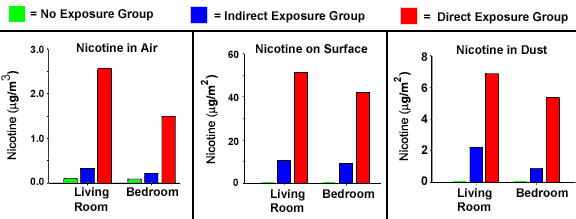 | Nicotine, Secondhand Smoke and Infants Smoking outside the home still exposes infants to nicotine |  |
 | Nicotine, Secondhand Smoke and Infants Smoking outside the home still exposes infants to nicotine |  |
|
March 4, 2004
Lung cancer and cardiovascular problems in non-smokers have been linked to secondhand smoke. Children exposed to secondhand smoke are more likely to suffer from lung diseases, ear infections and asthma. Many smokers believe that they can protect their children from tobacco smoke if they smoke away from their kids, for example, by smoking outside their homes. A new study from researchers at San Diego State University and the Centers for Disease Control and Prevention suggests that these parents may NOT be offering much protection to their children from secondhand smoke. The researchers studied 49 households with children less than one year old. These households were divided into three types:
The amounts of nicotine in the air, dust, on furniture and on the finger of the mothers' index fingers were measured. Urine and hair samples from the babies were also collected and tested for nicotine and continine. (Continine is a chemical the body produces when it breaks down nicotine.) |
Results |
Higher amounts of nicotine were found in the air, on furniture surfaces and in dust in the homes of the indirect and direct exposure groups than in the homes of the no exposure (non-smoking) group. The nicotine levels in the living rooms and bedrooms of the direct exposure group were many times higher than those in the rooms of the indirect exposure group. (No nicotine was detected on surfaces and in dust in the homes of the no exposure group.) |
 |
Infants who lived in households where they were exposed directly to tobacco smoke had higher levels of continine in their urine and higher levels of nicotine in their hair than infants in the indirectly exposed group or the no exposure group. Mothers in both the indirect exposure and direct exposure groups had similar levels of nicotine on their fingers. (No nicotine was found on the fingers of mothers in the homes of the no exposure group.) |
Household Contamination by Secondhand Smoke The results from this study show that secondhand smoke can
contaminate a house even if cigarettes are smoked outside. Moreover,
nicotine levels in babies who live in houses where people smoke outside
are much higher than in babies who live with non-smokers.
The results from this study show that secondhand smoke can
contaminate a house even if cigarettes are smoked outside. Moreover,
nicotine levels in babies who live in houses where people smoke outside
are much higher than in babies who live with non-smokers.Babies who live with smokers may be exposed to contaminated particles from secondhand smoke in several ways. First, infants may inhale the smoke from a cigarette or the exhaled air from a smoker. Even if cigarettes are not smoked near a baby, cigarette fumes may contaminate dust that settles in carpets, on toy and furniture surfaces and on the floor. These objects can remain contaminated for several months! Because babies spend a lot of time crawling on the floor and put toys in the mouths, they are especially at risk to ingest this contaminated dust. Smokers may also contaminate their homes by bringing in clothing exposed to smoke.
Protecting Non-smokers The data suggest that only a complete ban on smoking will protect a
household from secondhand smoke contamination. Even people who tried to
protect their babies from secondhand smoke by smoking outside still
contaminated their homes with nicotine. As the researchers write:
The data suggest that only a complete ban on smoking will protect a
household from secondhand smoke contamination. Even people who tried to
protect their babies from secondhand smoke by smoking outside still
contaminated their homes with nicotine. As the researchers write:
"...smoking outdoors, in different rooms, or when non-smokers are absent The researchers propose several steps to reduce the risks of secondhand smoke to non-smokers:
|
| References and further information:
|
| GO TO: | Neuroscience In The News | Explore the Nervous System | Table of Contents |
![[email]](./gif/menue.gif) Send E-mail |
 Get Newsletter |
 Search Pages |